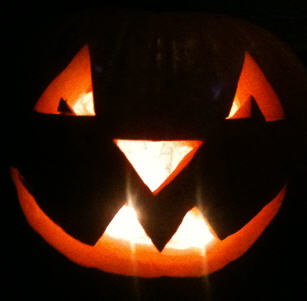Grown up Goblins
 Halloween conjures up images of the supernatural and here in the United States, pint sized goblins, witches, cats and ghosts - to name only a few of the traditional Halloween spooks. Halloween is a time honored holiday that possesses all the essential elements of childhood; make-believe, imitation, wonder and the ability to consume copious amounts of candy without it “going straight to my (your) hips.” Because of this, the ‘holiday’ strikes a deep chord with many people. It’s not uncommon to hear that All Hallows Eve wins the favorite holiday prize for many grown up goblins. When else is it not only acceptable but encouraged to dress up as something/someone you are not, become an anonymous as you like and roam the streets looking to fulfill your primordial urges (re: candy consumption)?
Halloween conjures up images of the supernatural and here in the United States, pint sized goblins, witches, cats and ghosts - to name only a few of the traditional Halloween spooks. Halloween is a time honored holiday that possesses all the essential elements of childhood; make-believe, imitation, wonder and the ability to consume copious amounts of candy without it “going straight to my (your) hips.” Because of this, the ‘holiday’ strikes a deep chord with many people. It’s not uncommon to hear that All Hallows Eve wins the favorite holiday prize for many grown up goblins. When else is it not only acceptable but encouraged to dress up as something/someone you are not, become an anonymous as you like and roam the streets looking to fulfill your primordial urges (re: candy consumption)?
Walk On The Wild Side
As a childish adult, the holiday reminds me to “walk on the wild side,” for a change, get out there and be what you wish, as the repercussions for tonight’s escapades will be measured. Whether you’re escorting the “little ones,” on their neighborhood candy ransack, hosting a ghoulish haunted house or simply manning the fortress providing the trick or treaters with cavities and scares, remember, this is a time for fantasy and an anything goes attitude. Embrace it and embrace your inner child.
Celtic Roots
Halloween had its beginnings in an ancient, pre-Christian Celtic festival of the dead. The Celts, who lived 2,000 years ago in the area that is now Ireland, the United Kingdom, and northern France, celebrated their new year on November 1. This day marked the end of summer and the harvest and the beginning of the dark, cold winter, a time of year that was often associated with human death.
Present Halloween Traditions
Virtually all present Halloween traditions can be traced to the ancient Celtic day of the dead. Halloween is a holiday of many mysterious customs, but each one has a history, or at least a story behind it. The wearing of costumes, for instance, and roaming from door to door demanding treats can be traced to the Celtic period and the first few centuries of the Christian era, when it was thought that the souls of the dead were out and around, along with fairies, witches, and demons. Offerings of food and drink were left out to placate them. As the centuries wore on, people began dressing like these dreadful creatures, performing antics in exchange for food and drink. This practice is called mumming, from which the practice of trick-or-treating evolved. To this day, witches, ghosts, and skeleton figures of the dead are among the favorite disguises. Halloween also retains some features that harken back to the original harvest holiday of Samhain, such as the customs of bobbing for apples and carving vegetables, as well as the fruits, nuts, and spices cider associated with the day.
All-Hallows-Even
The word Halloween is said to be first attested in the 16th century and represents a Scottish variant of the fuller All-Hallows-Even ("evening"), that is, the night before All Hallows Day. The phrase All Hallows is found in Old English (ealra hālgena mæssedæg, mass-day of all saints)

 Friday, October 28, 2011 at 10:01AM
Friday, October 28, 2011 at 10:01AM
Reader Comments (3)
Thanks for sharing this. I certainly agree that there are different ways in celebrating Halloween. Every country may have a unique tradition that has a deep connection on local history or belief. If the typical American Halloween is dominated with pumpkin heads and trick or treat parties, here in the Philippines, most people spend it on cemeteries to pray for their lost loved ones.